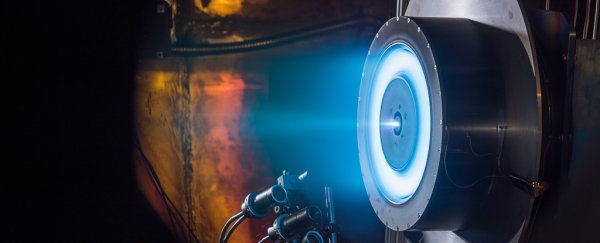We've made it to the Moon, but if we're going to start exploring the rest of our Universe, we're going to need better spacecraft. With that in mind, NASA has just awarded a US$67 million contract to develop a new electric propulsion system that could eventually take us much deeper into space.
In essence, electricity is used in place of a chemical propellant to get a spacecraft moving. The tech is slated to be used in the upcoming Asteroid Redirect missions, which aim to explore the ways we could deflect an asteroid headed to Earth, as well as a manned trip to Mars, scheduled for around 2030.
We've already seen cars start to make the switch to electric, and now our spaceships are going the same way.
Solar panels will be used to generate an electric charge (of course, cloud cover isn't a problem in space), and the on-board propellant will be ionised using the harvested electricity. These positively charged ions, created by trapping electrons in a magnetic field, are then accelerated out of the ship to provide thrust.
Electric propulsion isn't exactly new – NASA says it's been working on it for more than 50 years – but as with any technology, it needs to be made cost-effective, safe, and stable before it can be used in a mission. By awarding the new three-year contract to Aerojet Rocketdyne, NASA is hoping to to speed along the process.
"Work performed under the contract could potentially increase spaceflight transportation fuel efficiency by 10 times over current chemical propulsion technology and more than double thrust capability compared to current electric propulsion systems," said NASA.
When we start talking about long-distance space trips (the journey to Mars could take eight months or so), fuel efficiency becomes very important. Being able to travel longer distances with less fuel is crucial if we're going to get further out into the great beyond.
Aerojet Rocketdyne will use a reference design developed by NASA to produce a thruster, power processing unit (PPU), low-pressure xenon flow controller, and electrical harness. Xenon is commonly used as a propellant in ion propulsion systems because of the relative ease with which it can be ionised.
"Through this contract, NASA will be developing advanced electric propulsion elements for initial spaceflight applications, which will pave the way for an advanced solar electric propulsion demonstration mission by the end of the decade," said NASA associate administrator Steve Jurczyk.
"Development of this technology will advance our future in-space transportation capability for a variety of NASA deep space human and robotic exploration missions, as well as private commercial space missions."
NASA's Dawn Mission probe also uses solar-electric propulsion, but as The International Business Times reports, the thrusters being developed by Aerojet are expected to be around five times more powerful.
